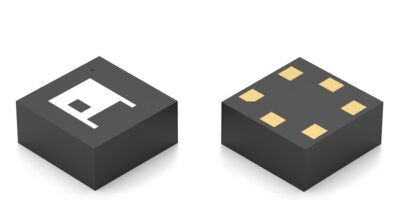MEMS humidity sensor is designed for long term stability
A MEMS sensor from Würth Elektronik measures just 2.0 x 2.0 x 0.9mm. The WSEN-HIDS humidity sensor has a temperature-compensated digital output.
It is based on MEMS technology which consists of a dielectric polymer which absorbs or releases water molecules in proportion to the relative humidity in the surroundings, thereby changing the permeability of a capacitor structure. The humidity sensor with integrated analogue-digital converter (ADC) and temperature sensor can be connected to commonly used microcontrollers via a serial peripheral interface (SPI) or I2C interface. There is also a software development kit (SDK), enabling users to individually set data rates and use the interrupt pin.
Its small size and minimal energy requirement make it suitable for use in building automation, cooling systems, heating, ventilation, air conditioning but it can also be used for data loggers, as well as stationary and portable IoT applications.
There is also an evaluation board available from Würth Elektronik. The MEMS sensor delivers calibrated measurement results with accuracy of ±3.5% RH in the 20 per cent to 80 per cent RH humidity range. Data output is in the millisecond range, says Würth Elektronik. Condensate forming on the surface of the polymer structure can be removed by activating a built-in heater. This allows the sensor to generate measured data again within a very short time. The operating temperature range of the robust sensor is -40 to +120 degrees C.
The WSEN-HIDS sensor promotes rapid terminal device development because developers can use a digital output directly via I2C or SPI and do not have to worry about calibration or temperature compensation, commented Vinod Kumar Ramu, product manager at Würth Elektronik eiSos. “The sensor’s interrupt pin can also be used to wake up the microcontroller if the humidity changes” he added. This makes it particularly well-suited for economical and low maintenance monitoring functions.
The current consumption of the humidity sensor is 8.9 microA in continuous operation with measurement data available every second. When used with a CR2032 button cell with 230 mAh capacity, this corresponds to a battery life of about three years, reports Würth. By reducing the sampling rate, applications can stay maintenance free for a longer period.
For terminal devices, the miniaturised WSEN-HIDS sensor allows manufacturers to integrate data evaluation for humidity and temperature.
The sensor is now available from stock without a minimum order quantity as a belt section or tape and reel package.
Würth Elektronik eiSos Group manufactures electronic and electromechanical components for the electronics industry. Würth Elektronik eiSos is one of the largest European manufacturers of passive components and is active in 50 countries, with production sites in Europe, Asia and North America supplying customers worldwide.
The company’s product range includes EMC components, inductors, transformers, RF components, varistors, capacitors, resistors, quartz crystals, oscillators, power modules, wireless power transfer, LEDs, sensors, connectors, power supply elements, switches, push-buttons, connection technology, fuse holders and solutions for wireless data transmission.




